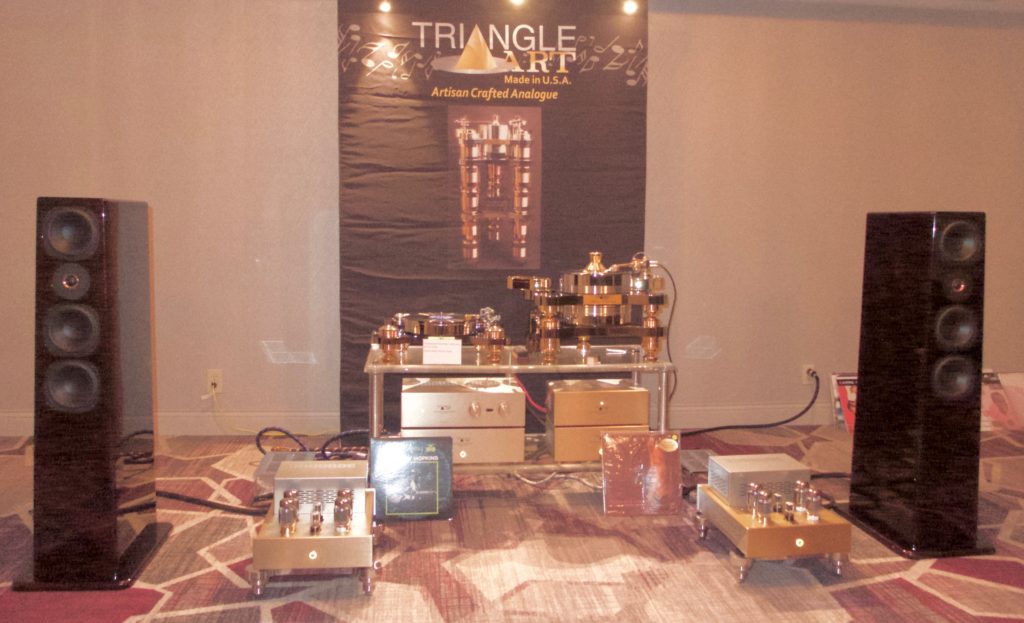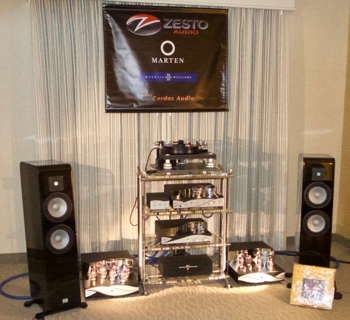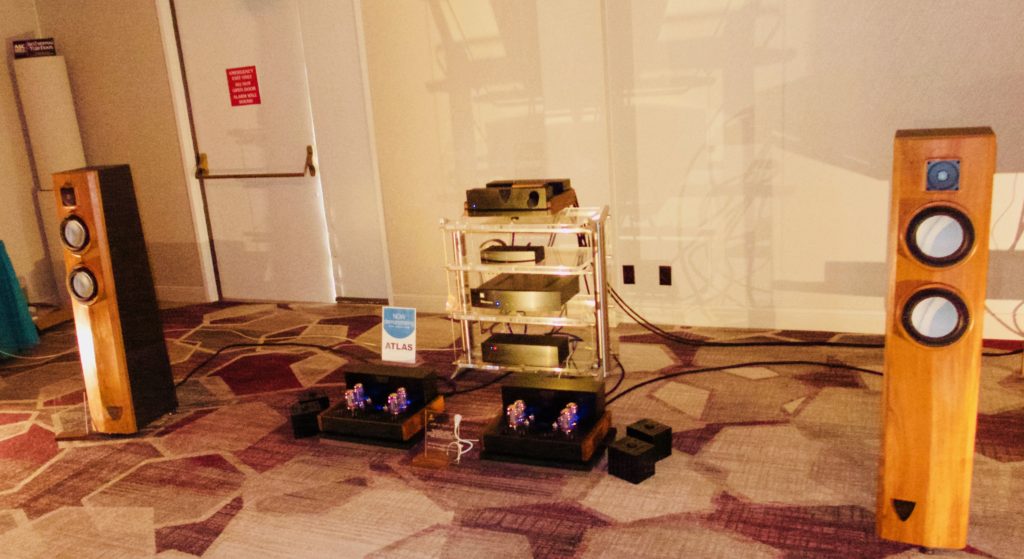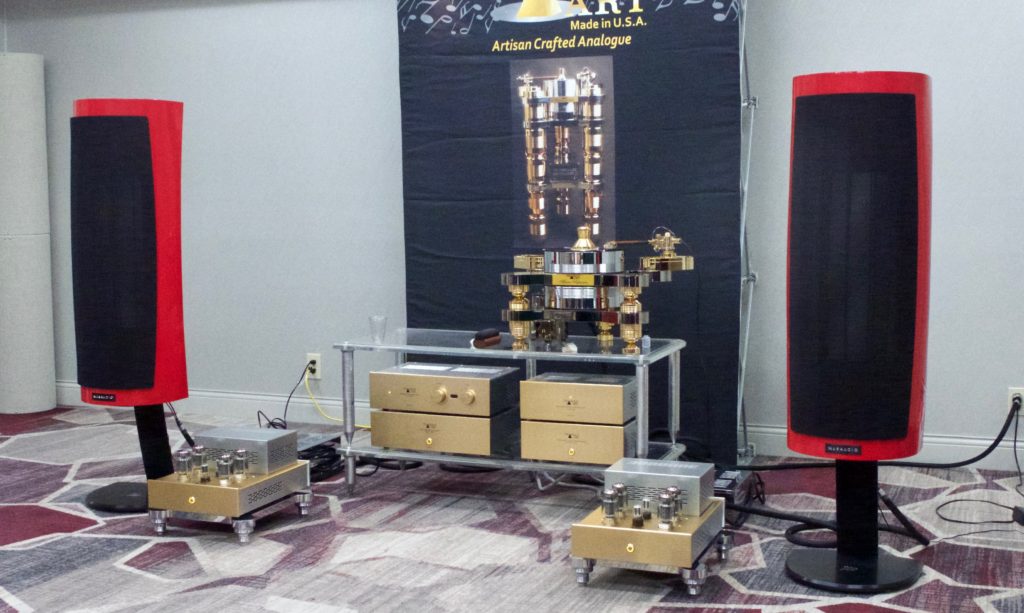
As at any show, there were some exhibitors that we feel deserve some special recognition. For this show, I’m also signaling out a product that I would most like to review. We congratulate these exhibitors, and we hope they will proudly display their Beatnik Bongos Award as much as we enjoyed hearing your system or products at future shows.
Best Sound of the Show – The TriAngle Art and Angel City Audio Room

I really don’t know what more to say about this system other than it was one of the three most musically satisfying rooms at the show. Combine this with having as good or better audio effects and the most magical and quietest sound from LPs, and you have the room that did more things right than any other room at the show.
System Details
Angel City Audio was showcasing their Seraphim Prime speakers ($25,000/pair).
TriangleArt was using two Apollo moving-coil cartridges ($8,000 each) mounted on TriangleArt Osiris II tonearms ($6,800 each). The two turntables were the TriangleArt Maestro turntable ($7,500) that I reviewed earlier this year and a TriangleArt Master Reference turntable system ($39,999).
The electronics were the TriangleArt Reference Tube Phono stage ($12,999) and the TriangleArt Reference Tube preamp ($18,999). When I was in the room, they were using the TriangleArt Reference tube monoblocks ($18,998/pair). I was lucky enough to bring these home for a review, so stay tuned for that. The cables were the TriangleArt Rhea Reference cable system. I continue to be impressed with the TriangleArt electronics at each show I go to, so I’m really excited to have a chance to review them.
Best System Under $100,000 – Zesto Audio

The Zesto Audio room was also something special. I would say in most ways it was the equal to the TriAngle Art and Angel City Audio Room. I expect the biggest differences I could hear came from the turntable system. I would have loved to hear this system with the TriAngle Art turntable, tonearm, and cartridge. Still, it was as musically satisfying as any system at the show.
System Details
They were using a Merrill Williams Audio REAL 101.2 Turntable ($7,200) with a Tri-Planar U2 (classic 10″) tonearm (two, $7,200 each) with a Benz Micro Gullwing SLR mc cartridge ($3,600) and an Ortofon Cadenza Mono mc cartridge ($1,280). The electronics were a Zesto Audio Andros Tessera Vacuum Tube Phono Stage ($12,000), Zesto Audio Allasso Step Up Transformer ($2,995), a Zesto Audio Leto 1.5 Vacuum Tube Preamp ($7,500) and Zesto Audio Eros 300 monoblock Class A power amplifiers ($19,900/pair). The speakers were the Marten Django L speakers ($10,000/pair).
They were also using using a Stillpoints ESS42-26-4 Rack ($10,000), Stillpoints Ultra 6 Feet (under power amps) ($899 each), Cardas Audio Speaker Cables – Clear Beyond ($4,085/2-meter pair), Cardas Audio Interconnects – Clear Beyond ($1,875/1-meter pair), Cardas Audio Interconnects – Clear Beyond ($2,675/2-meter pair), Cardas Audio Power Cords – Clear Beyond ($522/1.5-meter), and Cardas Audio Phono cable – Clear Beyond ($573/1-meter).
Best System Under $50,000 – Margules Group

The Marqules Group’s room could have easily been given the award for best sound at the show. When visiting with other people at the show, I discovered I wasn’t the only person considering this room for the best system at the show. There was an ease and naturalness to this system that simply drew me into the music. Its only sins were of omission, and they were small and few. My real question is why is this company not better known in the US?
System Details
The system consisted of the newest versions of their Margules U280-sc Black 1.3 Tube Class A Stereo/Mono Amplifiers, Margules SF220 Black 1.2 Tube Class A Preamplifier, Margules Orpheus 1.3 Ceramic Driver Tower Speakers, Magenta TT-10 Turntable, Magenta FZ47db Phono Stage, Magenta BTV4 Wireless Receiver and the Magenta DAC.
Most Promising Debut – Muraudio SP1 Electrostatic Loudspeakers

The Muraudio SP1 Electrostatic Loudspeakers ($14,700) were making their debut at this show. I have to say these are very exciting new speakers. The SP1 uses one of Muraudio’s proprietary electrostatic panels — SP stands for single panel. The electrostatic panels cover the range from 750Hz up and is mounted in a thick, very curved, mostly open-backed cabinet of birch plywood. Because the area behind the panel is open, the panel operates as a dipole. It radiates as much energy backward as forward.
If I had only heard these speakers in their room, they wouldn’t have won this award, but last Sunday afternoon they moved them down to the TriAngle Art room, and I was even more impressed with their potential.
To reproduce frequencies below 750Hz, the SP1 has four 6.5-inch dynamic drivers (that’s the driver’s frame size; the cone is about 5 inches across). These drivers are arrayed in pairs above and below the electrostatic panel, sunk about 2 inches into the enclosure which, per Harman, improves the phase alignment of their output with the panel’s output. The cones also point slightly to the side and not straight ahead to improve dispersion over an arc of about 120° and to ideally match the panel’s dispersion characteristics. Muraudio specs out the SP1 with a frequency response of 45Hz-22kHz, ±3dB, and a maximum output of 103dB measured at 2m.ou.
This is a speaker with a big WOW factor; I don’t know if over time that the wow factor would be a good or bad thing. I can tell you that the top end and midrange are very transparent, very open and the top-end is beautifully extended. My only real concern was in the lower midrange and upper bass. The bottom end had a lot of impact and speed that matched the midrange and top-end. It was just in that frequency range that the speaker sounded a little thick and slow compared to the deeper bass and midrange.
New Product I’d Most Like to Review – Whammerdyne 2A3 SE model DAA3+ RAM Amplifier

Without a doubt, this is the one product I would most like to hear in my system. The California Audio Show was the debut for the Whammerdyne 2A3 SE model DAA3+ RAM ($6,900) from Whammerdyne Heavy Industries. If you don’t already know, the DAA stands for Damn Awesome Amp. From what I heard at the show, I certainly think the name fits. This amp uses (dual) auto-formers (left and right channels) and front-panel input volume controls. These are custom wound tapped transformers of ultra-wide bandwidth with 23 precision attenuation steps. There are also selectable dual RCA source inputs (Input 1 and Input 2).
It uses ultra-custom made matched output transformers, special core material and high bandwidth, extremely low insertion loss, low distortion and low DCR design, -1 dB down 15 Hz and 85 Khz, gapped for 60 Ma standing current not subject to dc saturation, and low phase shift. The 2A3 output tubes can be upgraded, and the user can select from three options. It puts out 4+ watts per channel with peak power of 6.5 watts per channel; more than enough for my 104dB efficient Teresonic XR speakers.

Did they use any speakers in the Triangle Art room?
Yes, of course, they did and thanks for pointing out that I accidentally didn’t include them on the list. They were the wonderful Angel City Audio was showcasing their Seraphim Prime speakers ($25,000/pair).